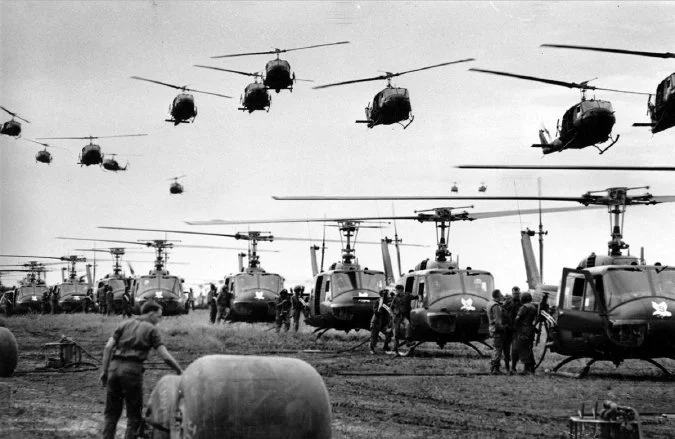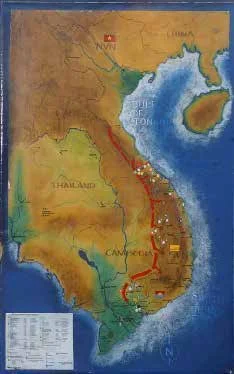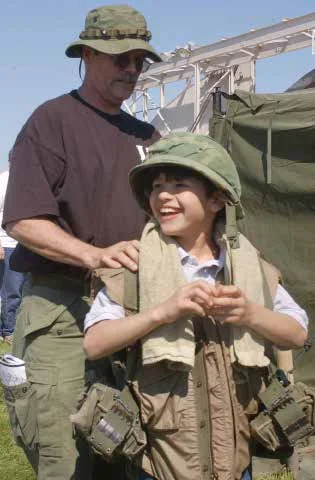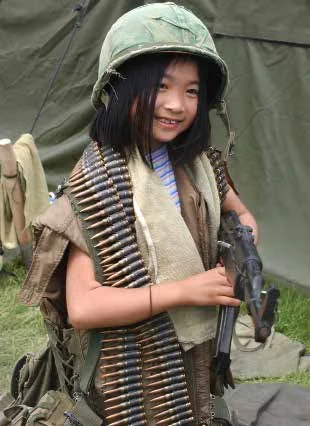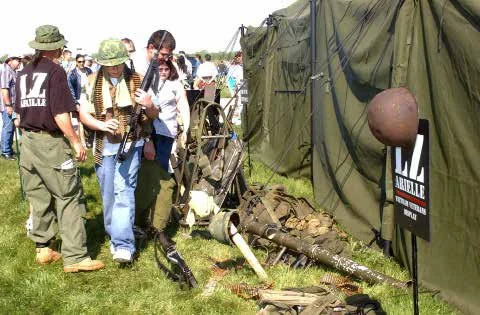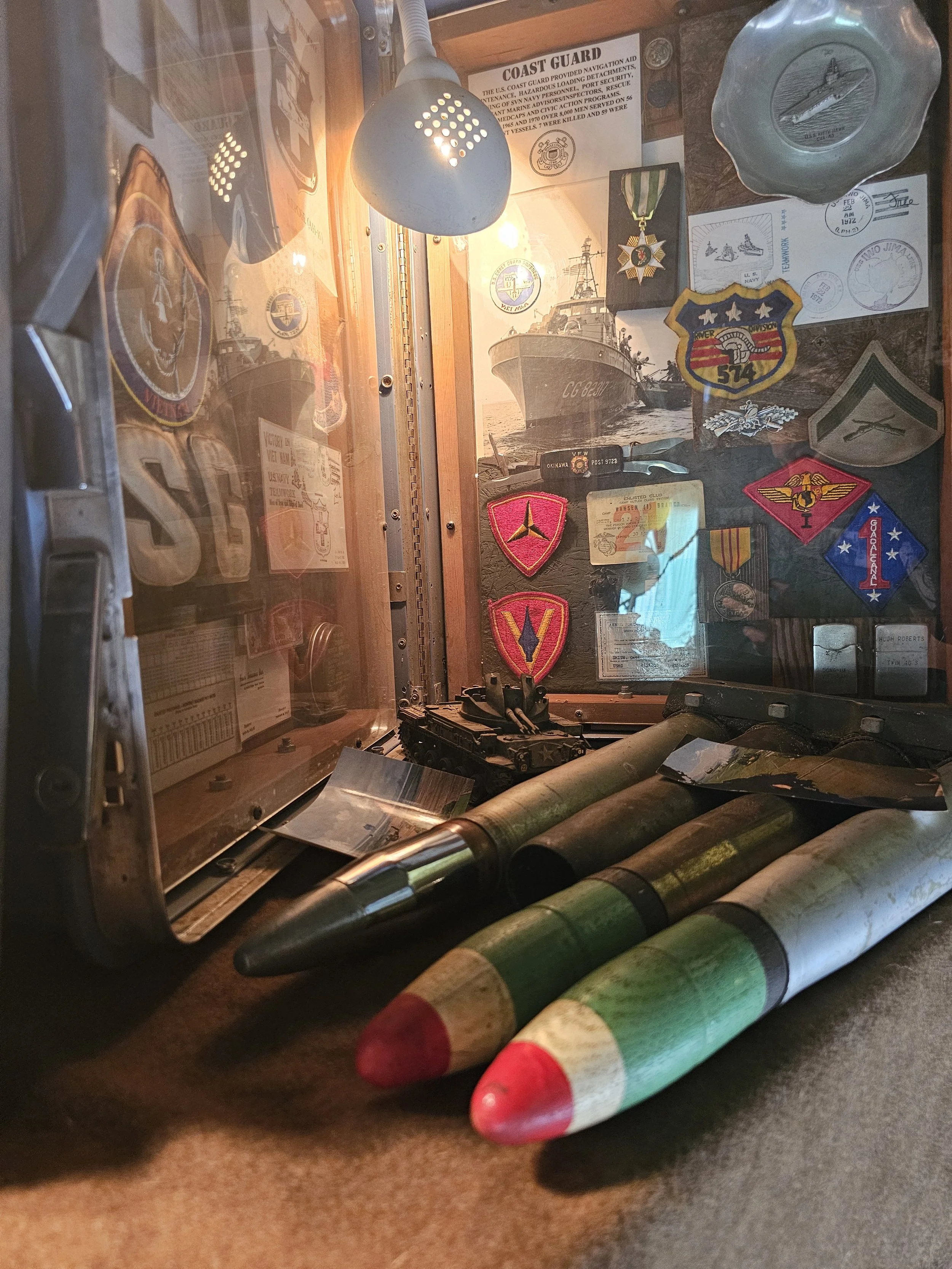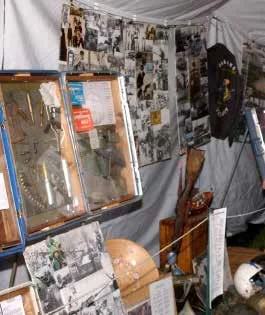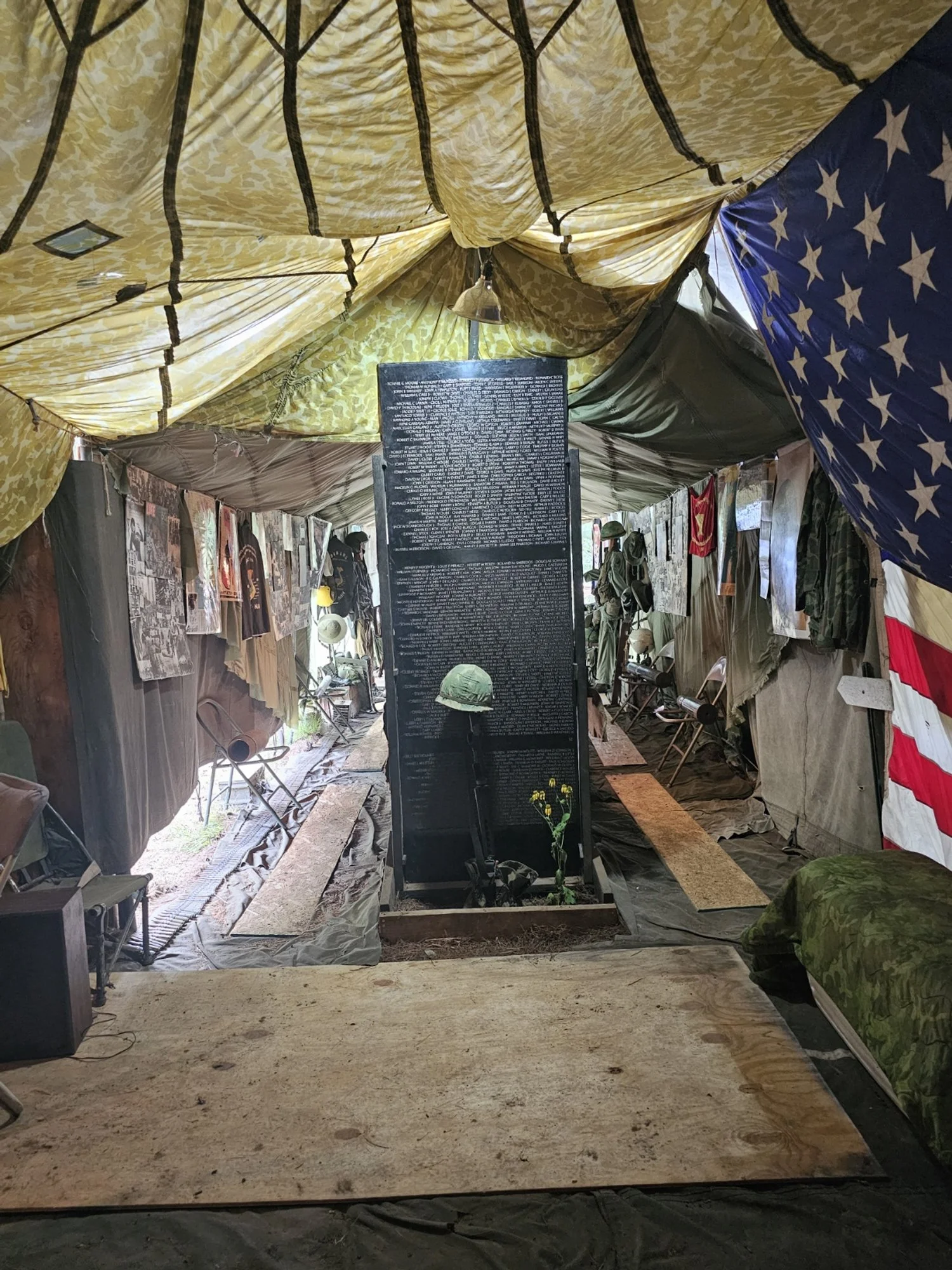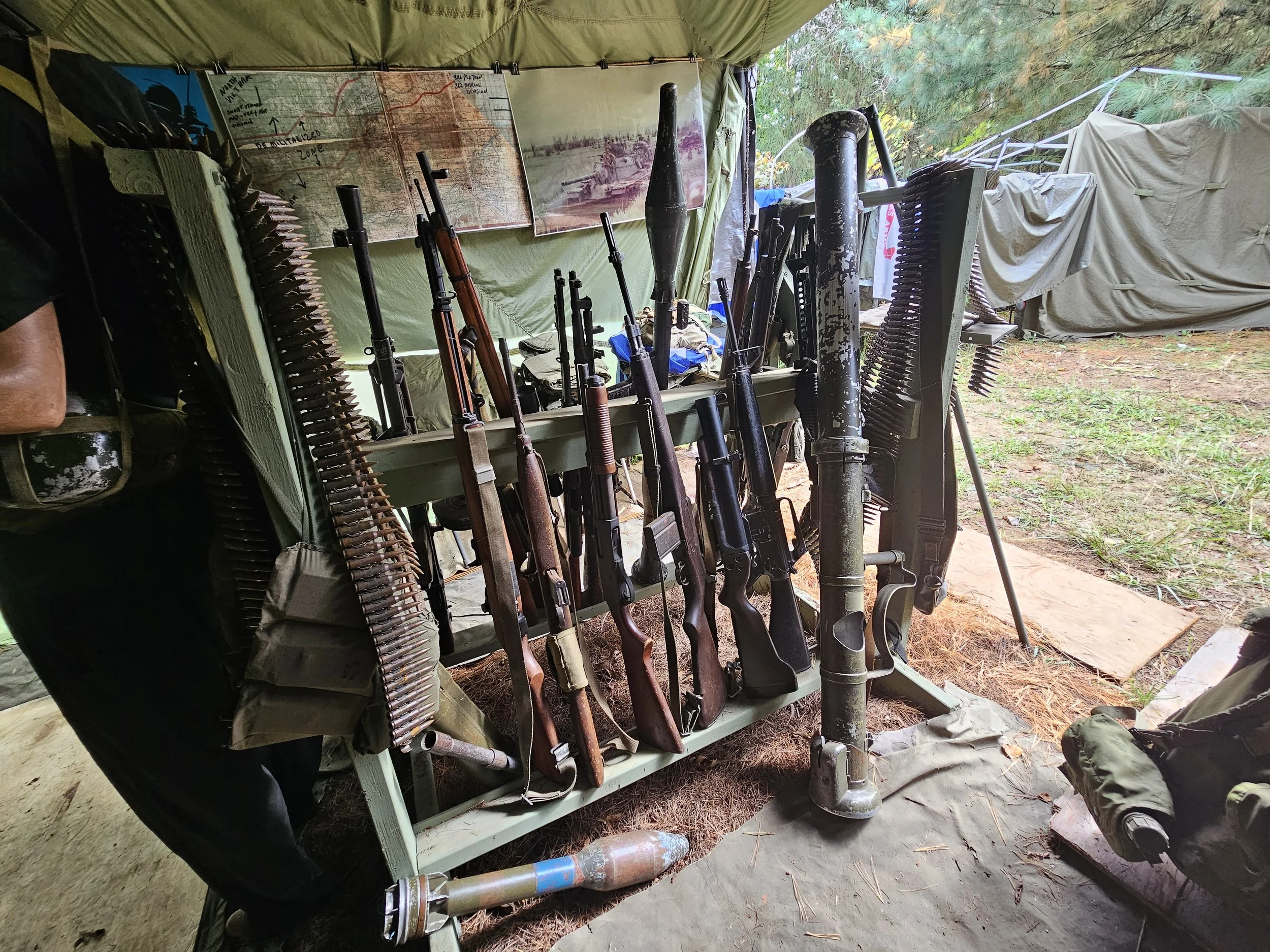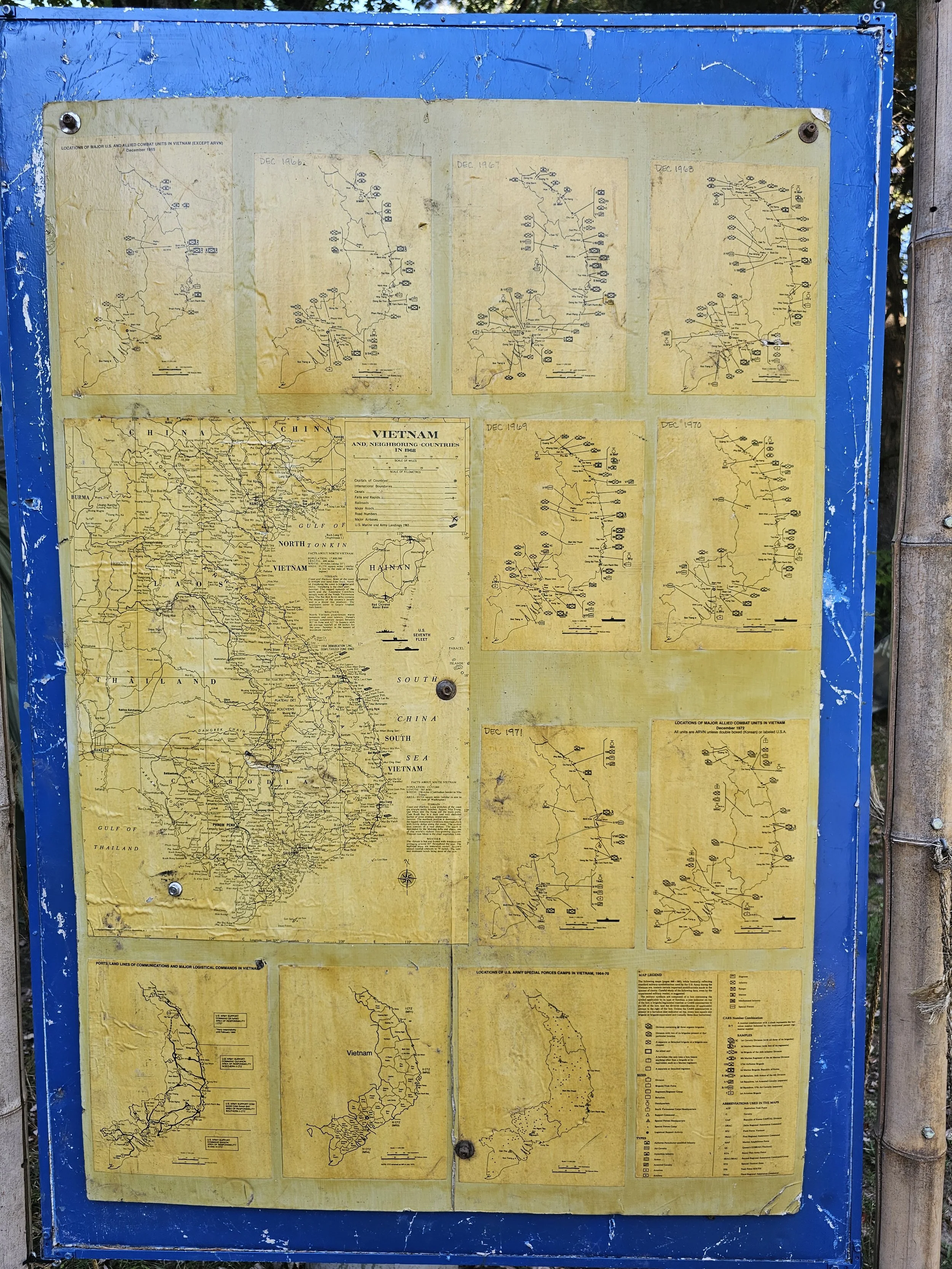
LZ ARIELLE
VIETNAM VETERANS DISPLAY
TO EDUCATE: The community
To HEAL: The veterans and the community
TO STOP ALL WARS: Forever more

“War is filthy and horrific, and these memories will be in your mind until the day you die.”
EDUCATING THROUGH ARTIFACTS
“War is filthy and horrific, and these memories will be in your mind until the day you die.”
For nearly two decades, Schaffer has collected and preserved items for the display. Some are pieces of equipment he personally brought home, while others were found through flea markets, garage sales, or even online auctions.
“I saved all this stuff that I brought back, and instead of putting it in my basement, I decided to take it out and bring it to schools to educate people.”
Initially, the exhibit was meant to complement the Moving Wall, a traveling Vietnam Memorial. Over time, Schaffer recognized that it also offered a valuable way to reach students, and since then he has visited more than 50 schools.
The Moving Wall helps communities remember the fallen, but as Schaffer points out, it doesn’t explain the war itself:
“I decided to do this because the Wall itself doesn’t really educate people as to what it’s all about.”
By contrast, LZ Arielle presents uniforms, weapons, documents, machinery, and photographs that show what the conflict was like.
“In combat, your senses are all so highly attuned, it’s unreal,” says Schaffer, who served with the 1st Aviation Brigade at Da Nang with the 11th Combat Air Group. “Your sight, smell, hearing. You don’t wash, because in the field the enemy can smell it. Your goal is to smell like the enemy. And every weapon has a distinct sound—you come to know those (different sounds). A lot of times we used the enemy’s weapons, because if you can confuse them for even a couple seconds, that could give you enough time to get out of there.”
During school visits, Schaffer has students dress in 20–30 pounds of authentic combat gear and carry replica weapons such as AK-47s or M60s. He assigns them squad roles—radio operator, squad leader, point man—and describes the trust soldiers had in each other: “you had to know if you were wounded, that somebody would go out and get you.”
He then explains what daily life meant for infantry: hours of walking, wading through swamps, and facing leeches, mines, and ambushes. “War is gross—it’s horrific,” he tells the students. “You’re looking for any signs of enemies and land mines, because in war, in combat, if you make a mistake, somebody dies.”
He drives the point home with vivid examples: “After stepping on a land mine, he might be horrifically dying—he might be twitching, talking to his mom—a lot of men did that before they died, and this guy is standing here in shock because he can’t believe what’s happening. And you have to return fire, or else you’ll die.”
THE COLLECTION
“The display consists of over 800 items with approximately 75% of the items coming from Vietnam. The display tells the story of the soldiers’ journey from basic training through his or her time in-country to the problems back home. Included is a section on the war protest movement. A ‘hands on’ display consists of all the equipment carried by the ‘grunts’ including an M-16 and an M-60. All weapons and ammo on display are de-milled (made inoperative).”
LIVING WITH MEMORIES
Although soldiers shared the same dreams and ambitions as their peers back home, Schaffer notes that every day was defined by survival.
“I’m fine on the Fourth of July—fireworks don’t bother me. But the smell of diesel, helicopters and wet canvas—I’m instantly there (in Vietnam).
This stuff happened 35 years ago, and it’s still right there—it just amazes me sometimes.”
Like many, Schaffer didn’t realize the depth of his trauma until years later. He is part of the 65% of Vietnam veterans who live with PTSD.
“I’M FINE ON THE FOURTH OF JULY—FIREWORKS DON’T BOTHER ME, BUT THE SMELL OF DIESEL, HELICOPTERS AND WET CANVAS—I’M INSTANTLY THERE.”
“I’M FINE ON THE FOURTH OF JULY—FIREWORKS DON’T BOTHER ME, BUT THE SMELL OF DIESEL, HELICOPTERS AND WET CANVAS—I’M INSTANTLY THERE.”
“In combat, your senses are all so highly attuned, it’s unreal,” says Schaffer, who served with the 1st Aviation Brigade at Da Nang with the 11th Combat Air Group. “Your sight, smell, hearing. You don’t wash, because in the field the enemy can smell it. Your goal is to smell like the enemy. And every weapon has a distinct sound—you come to know those (different sounds). A lot of times we used the enemy’s weapons, because if you can confuse them for even a couple seconds, that could give you enough time to get out of there.”
TIMELINE OF U.S. INVOLVEMENT
1845 – USS Constitution anchors in Da Nang; Marines land after a Catholic bishop’s murder.
1868 – A U.S. frigate sinks a pirate ship in Da Nang Harbor but one sailor is lost.
1942 – First Flying Tiger casualty when an American is shot down over Hanoi.
1945 – U.S. arms provided to Vietminh forces against the Japanese.
1947 – Truman Doctrine pledges aid to nations resisting communism.
1950 – $10 million in American assistance sent to French military; MAAG created in Saigon.
1952 – The U.S. funds one-third of French war costs.
1954 – Geneva Convention on Indochina; Eisenhower commits support to South Vietnam.
1961 – Kennedy boosts number of American advisors.
1964 – Gulf of Tonkin incident leads to Johnson receiving authority to escalate.
1965 – Operation Rolling Thunder bombing begins; first ground troops arrive.
1968 – Tet Offensive; Johnson halts bombing to open talks.
1969 – Nixon launches “Vietnamization” and staged withdrawals.
1970 – U.S. forces invade Cambodia.
1971 – ARVN with U.S. support invade Laos; Kissinger begins secret talks.
1972 – North Vietnamese launch a major offensive; U.S. ground combat ends.
1973 – Paris Peace Agreement signed; cease-fire begins; POWs released.
1975 – Saigon falls; U.S. embassy evacuated.
WHO SERVED
26.8 million U.S. males eligible for service (1961–1975)
10 million served worldwide
2.7 million served in Vietnam
8.7 million enlisted
1.7 million drafted
8.6 million examined for draft
10 million deferred or exempted
171,000 conscientious objectors
1 million draft evaders
25,000 convicted of draft offenses (3,250 served time)
250,000 did not register
Women in Vietnam
7,848 nurses (8 killed)
13,000 USO & Special Services personnel
African Americans
11% of U.S. forces in Vietnam
12% of U.S. combat deaths
Other Details
5.2 million acres defoliated
8 million tons of bombs dropped
APO 96225 (Poem by Larry Rottmann)
A soldier writes home:
At first: “Sure rains here a lot.”
His mother urges honesty: “Tell us what it’s really like.”
He replies: “Wow, you ought to see the funny monkeys!”
She insists again: “Don’t hold back.”
He says: “The sunsets here are spectacular.”
Finally, she pleads: “Tell us everything.”
So he writes: “Today I killed a man. Yesterday I helped drop napalm on women and children. Tomorrow we are going to use gas.”
His father responds: “Please don’t write such depressing letters. You’re upsetting your mother.”
From then on, his letters return to: “Sure rains a lot here…”
LESSONS FROM VIETNAM
“Those who forget the past are condemned to repeat it.” —Santayana
Though clearly a war, the U.S. government classified Vietnam as a “conflict.” Many veterans feel this distinction contributed to the hostility they faced when returning home. Decades later, healing continues through memorials, community education, and acknowledgment of the sacrifices made.
HANDS-ON: GEAR & WEIGHTS
Helmet & liner: 3 lbs
Web gear (canteens, rations, ammo, poncho, grenades, clothes): 22 lbs
Flak jacket: Panel style (10 lbs), Vest style (6 lbs)
M1 Carbine: 6 lbs (.30 cal, 250 m)
M14 Rifle: 10.5 lbs (.308 cal, 460 m)
M16 Rifle: 7.6 lbs (.223 cal, 650 RPM, 460 m)
Bandoliers: M14 (7×20 rounds), M16 (133 rounds total, 4.7 lbs)
Rocket launcher (loaded): 14 lbs
M72 LAW: Light anti-tank weapon
M79 Grenade Launcher: 6.45 lbs
Shotgun: 7.5 lbs
SKS Rifle: 8.4 lbs
Claymore mine: 7.5 lbs
Radio PRC-25 with spare battery: 30 lbs
STATISTICS (estimates)
Casualties
U.S. Military: 58,000+ dead; 303,700 wounded; 2,000 MIA
South Vietnamese Military: 220,357 dead; 499,000 wounded
Other Allies: 5,227 dead
North Vietnamese/VC: 850,000 dead; 300,000 wounded
Civilians: 2 million dead; 4.5 million wounded
Refugees: 9 million displaced
Disabled U.S. veterans: 519,000
Additional Facts
65% of U.S. veterans have PTSD
18% of U.S. deaths came from accidents or friendly fire
Michigan Statistics
400,000 served in armed forces
161,000 served in Vietnam
2,649 killed
72 MIA
Comparisons
Deaths: WWII (405,399), Korea (54,246), Vietnam (58,183)
Wounded-to-killed ratio: WWII (3.1:1), Korea (4:1), Vietnam (5.6:1)
Survival rate: WWII (71%), Korea (74%), Vietnam (81%)
Amputees: Korea (18%), Vietnam (28.3%)
Paralysis: WWII (3.1%), Vietnam (25.2%)
Costs
U.S. aid to South Vietnam: $24 billion
Direct U.S. war costs: $165 billion
Aid to North Vietnam from USSR/China: $3 billion
CONTACT
Email: lzarielle@aol.com
Schaffer explains that while much of the exhibit is made up of his own artifacts, it is costly to maintain. He welcomes donations of both items and financial support.
“I’d appreciate it if anybody has memorabilia for Vietnam and they’d like to donate it.”
The LZ Arielle Display continues to give countless people a clearer understanding of the Vietnam War and its lasting impact.
A VETERNAN’S MISSION
My name is Frank Schaffer, and I served in Vietnam from 1972 to 1973, working with helicopters during my tour of duty. Like many veterans, I continue to live with Post-Traumatic Stress Disorder, and I rely on the support of the VA to this day.
Despite these challenges, I believe it is my responsibility to share my story—because most people, especially younger generations, have little understanding of what truly took place in Vietnam.
The LZ Arielle Vietnam Veterans Display was created for that purpose. As both a memorial and a traveling museum, it invites visitors to step into the experience of Vietnam. The artifacts in this collection are personally curated and managed by me. Together, they represent not just military history, but the lived reality of the men who served.

